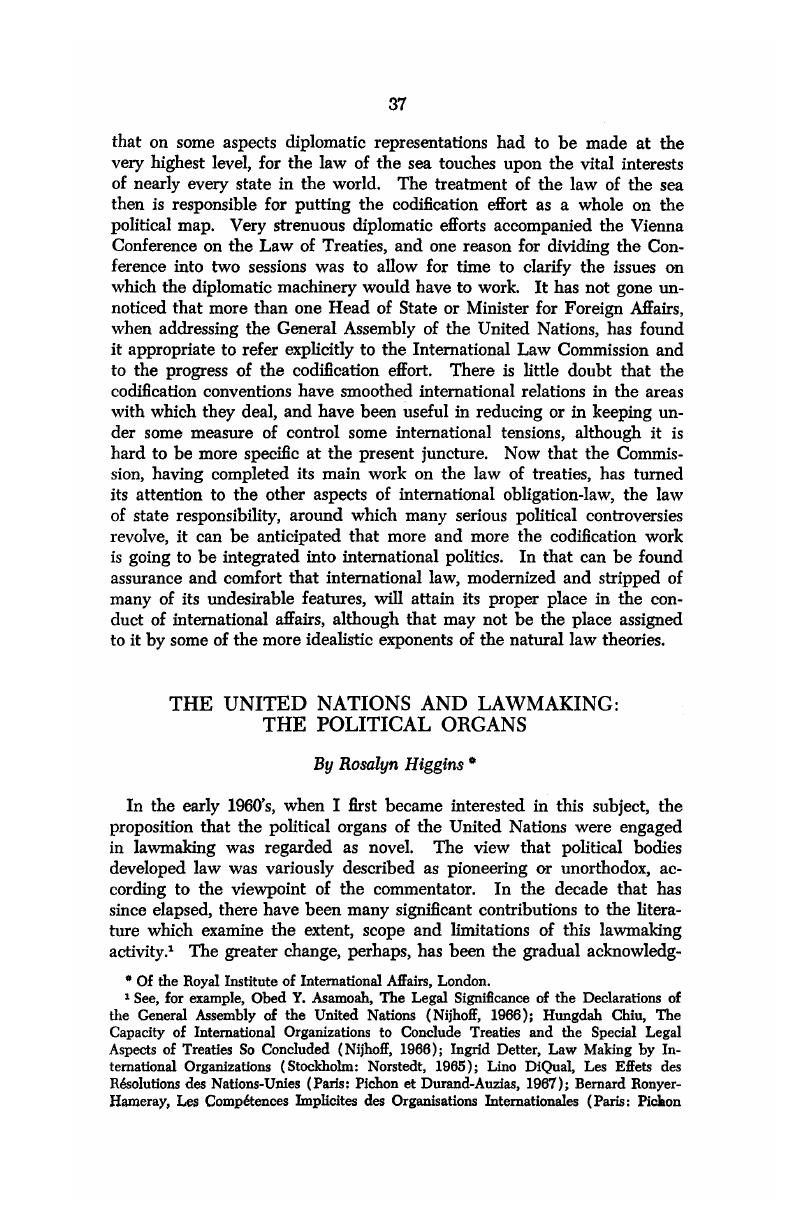Published online by Cambridge University Press: 28 March 2017

1 See, for example, Asamoah, Obed Y., The Legal Significance of the Declarations of the General Assembly of the United Nations (Nijhoff, 1966CrossRefGoogle Scholar); Chiu, Hungdah, The Capacity of International Organizations to Conclude Treaties and the Special Legal Aspects of Treaties So Concluded (Nijhoff, 1966)Google Scholar; Detter, Ingrid, Law Making by International Organizations (Stockholm: Norstedt, 1965Google Scholar); DiQual, Lino, Les Effets des Résolutions des Nations-Unies (Paris: Pichón et Durand-Auzias, 1967)Google Scholar; Ronyer-Hameray, Bernard, Les Compétences Implicites des Organisations Internationales (Paris: Pichkon et Durand-Auzias, 1962Google Scholar); Seyersted, Finn, Objective International Personality of Inter-Governmental Organizations. Do Their Capacities Really Depend upon the Conventions Establishing Them?” 34 Nordisk Tidsskrift for Internationaal Ret og Jus Gentium, Fase. 1 (1964)Google Scholar; Yemin, Edward, Legislative Powers in the United Nations and Specialized Agencies (Sijthoff, 1969)Google Scholar; Engel, Salo, “Procedures for the De Facto Revision of the Charter,” 1965 Proceedings, American Society of International Law 108-116Google Scholar; Falk, Richard, “On the Quasi-Legislative Competence of the General Assembly,” 60 A.J.I.L. 782-791 (1966)10.2307/2196928Google Scholar; Lande, Gabriella, “The Changing Effectiveness of General Assembly Resolutions,” 1964 Proceedings, American Society of International Law 162-170Google Scholar; Schachter, Oscar, “The Relation of Law, Politics and Action in the United Nations,” 109 Hague Academy Recueil des Cours 169-256 (1963, III)Google Scholar; Skubiszewski, Krzystof, “Forms of Participation of International Organizations in the Lawmaking Processes,” 18 Int. Organization 790-805 (1964)10.1017/S0020818300025327CrossRefGoogle Scholar.
2 E.g., in The Development of International Law through the Political Organs of the United Nations (Oxford University Press, 1963); and “The Development of International Law by the Political Organs of the United Nations,” 1965 Proceedings, American Society of International Law 116-124.
3 South West Africa Cases, [1966] I.C.J. Rep. 291.
4 Loc. cit., note 2.
5 Falk, , “On the Quasi-Legislative Competence of the General Assembly,” 60 A.J.I.L. 782-791 (1966)10.2307/2196928Google Scholar.
6 North Sea Continental Shelf Cases, [1969] I.C.J. Rep. 3 at 43; 63 A.J.I.L. 591 (1969).
7 Ibid.
8 Goldie, See, “Sedentary Fisheries and the North Sea Continental Shelf Cases,” 63 A.J.I.L. 536 (1969)Google Scholar, and Friedmann, , “The North Sea Continental Shelf Cases—A Critique,” 64 ibid. 229 (1970)Google Scholar.
9 See “Unanimity, The Veto, Voting, Weighted, Special and Simple Majorities and Consensus as Modes of Decision in International Organizations,” in Cambridge Essays in International Law (Stevens, 1965)Google Scholar.
10 North Sea Continental Cases, Shelf, Judgment, [1969] I.C.J. Rep. 43Google Scholar.
11 South West Africa Cases, Judgment, Merits [1966] I.C.J. Rep. 170.
12 Ibid.
13 Ibid. 432.
14 “Forms of Participation of International Organizations in the Lawmaking Processes,” 18 Int. Organization 790-805 (1964).
15 At p. 153.
16 “Decisions of International Organs as a Source of International Law,” 94 Hague Academy, Receuil des Cours 265-364 (1958, II)Google Scholar.
17 In 93 ibid. 5 (1957. II).
18 [1966] I.C.J. Rep. 169.